Abstract
OBJECTIVE: To assess the role of surgery on survival of patients with grade II gliomas of the cerebral hemispheres. METHODS: One hundred and thirty one low grade hemispheric gliomas surgically treated (biopsied patients excluded) between 1978 and 1989 were retrospectively reviewed. Thalamic, basal ganglia, callosal, or ventricular location were not considered. All tumours were World Health Organisation (WHO) grade II gliomas: 42 fibrillary and 11 gemistocytic astrocytomas, 49 oligodendrogliomas, and 29 oligoastrocytomas. Patients' ages ranged from 14 to 63 (mean 32.9, median 34) years, Karnofsky performance from 0.50 to 0.90 (mean 80.7, median 80), and postsurgical follow up of the living patients from 24 to 190 (mean 97.02, median 93) months. Postoperative external radiotherapy was performed in 49 cases. RESULTS: The overall survival probability at five years was 97.1%, at eight years 76.1%, and at 10 years 62.7% (median survival time 144 months). The impact on survival of the following variables was analysed: age (< 20, 21-40, and > 40 years), Karnofsky score (80-100, 70 < or = 70), histology, tumour extension (T1 < 3 cm, T2 3-5 cm, T3 > 5 cm maximum diameter), extent of surgical resection (S1 radical, S2 subtotal < 10% residual tumour, S3 partial-10%-50% residual tumour), and radiotherapy (either performed or not). A significant positive association with survival at univariate analysis was found for the age group < 20 years (P = 0.003), for total and subtotal surgical resections (S1 and S2; P < 0.001) and for the non-irradiated patients (P = 0.0049), whereas a shorter survival probability was noticed for gemistocytic astrocytomas (P < 0.001) and for tumour extension > 5 cm (T3; P = 0.0193). Karnofsky performance did not show any significant association with survival. The most relevant factor affecting survival at the multivariate analysis was the extent of surgical resection, which resulted as the only variable retaining a significant value (P = 0.001, risk factor = 2.20). CONCLUSIONS: The data strongly support the role of a surgical removal as extensive as possible in the treatment of these tumours.
Full text
PDF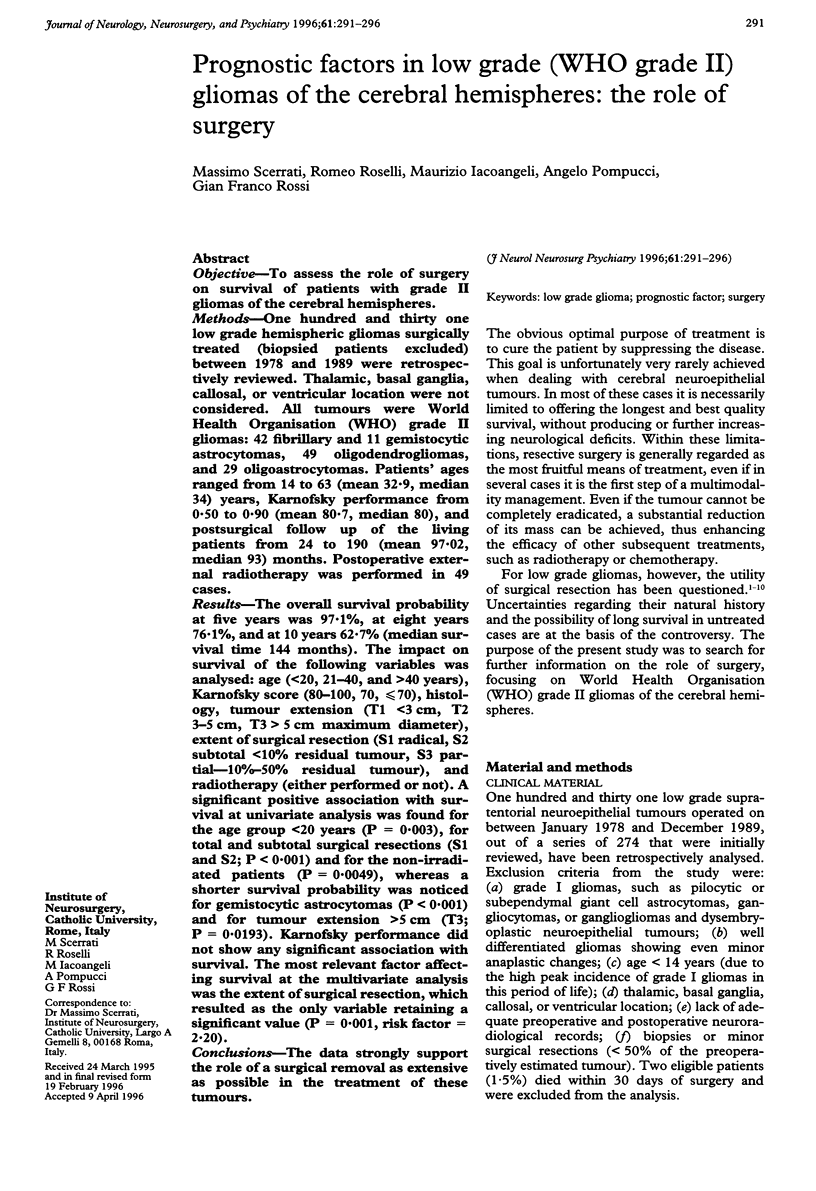
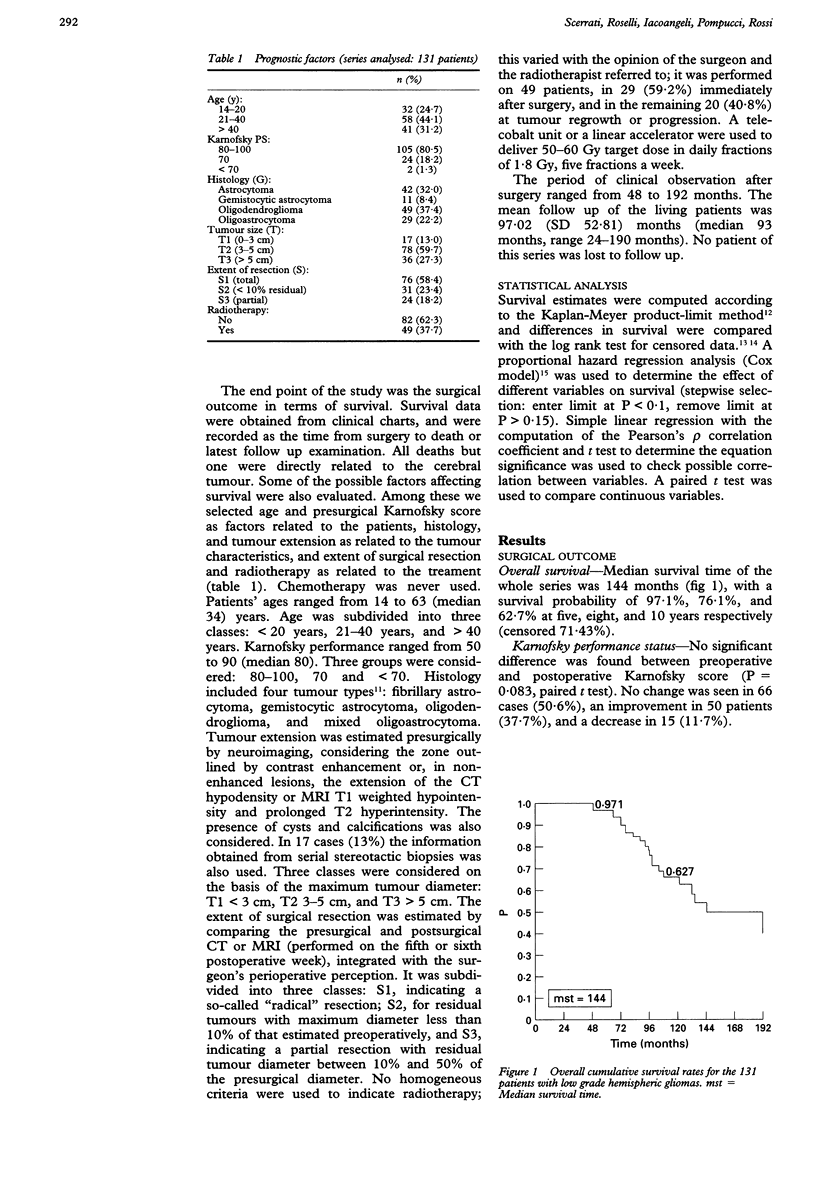
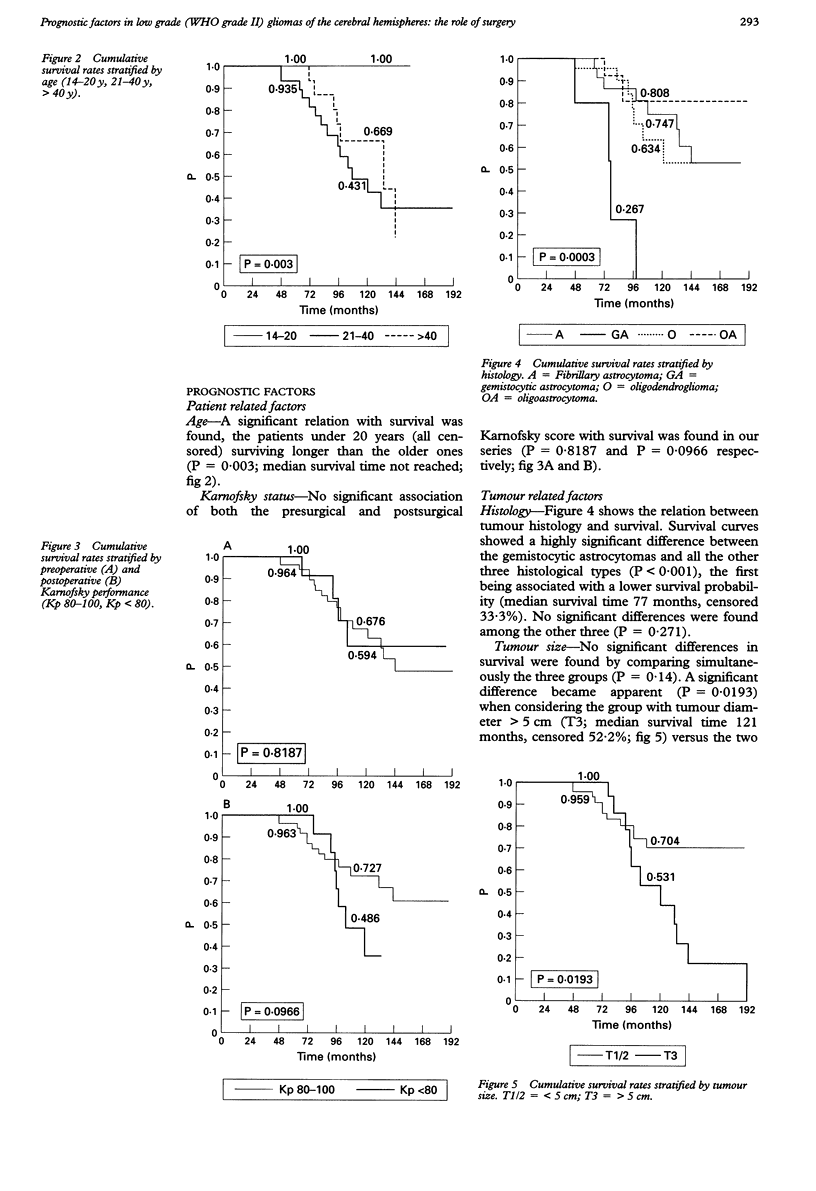
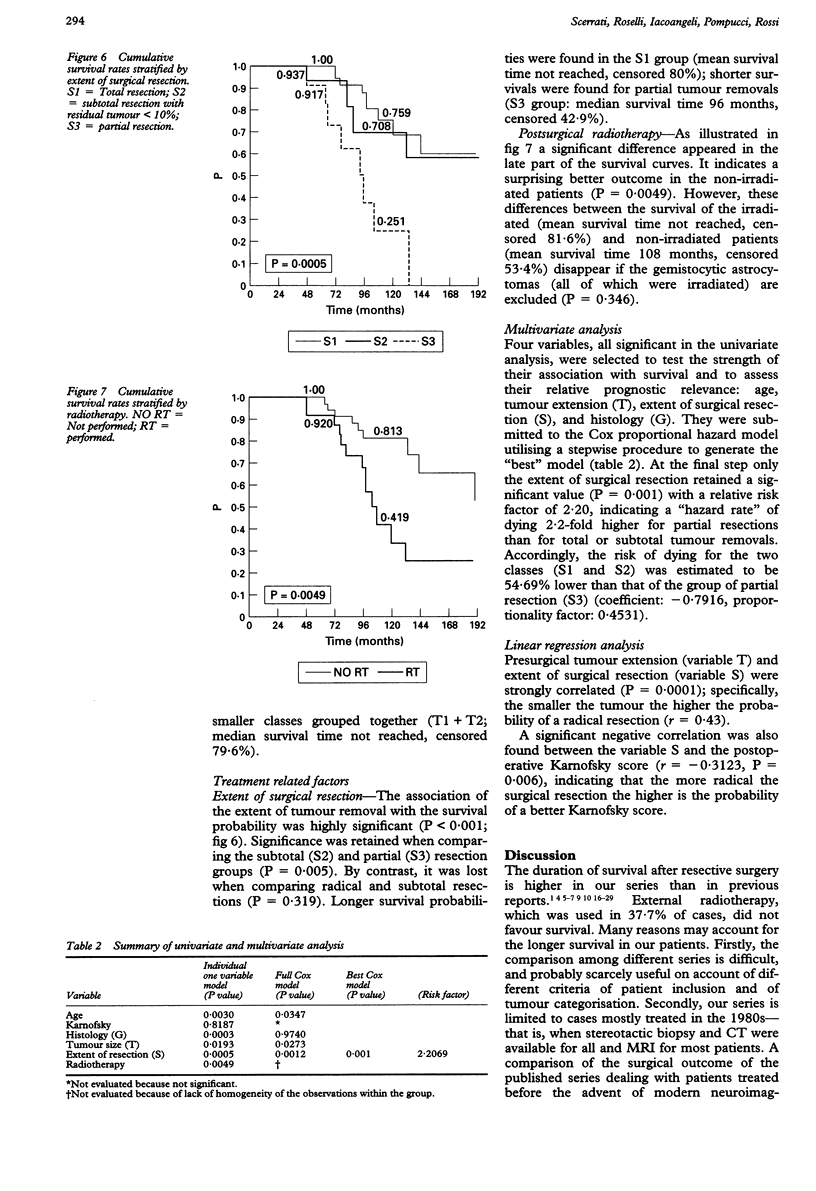
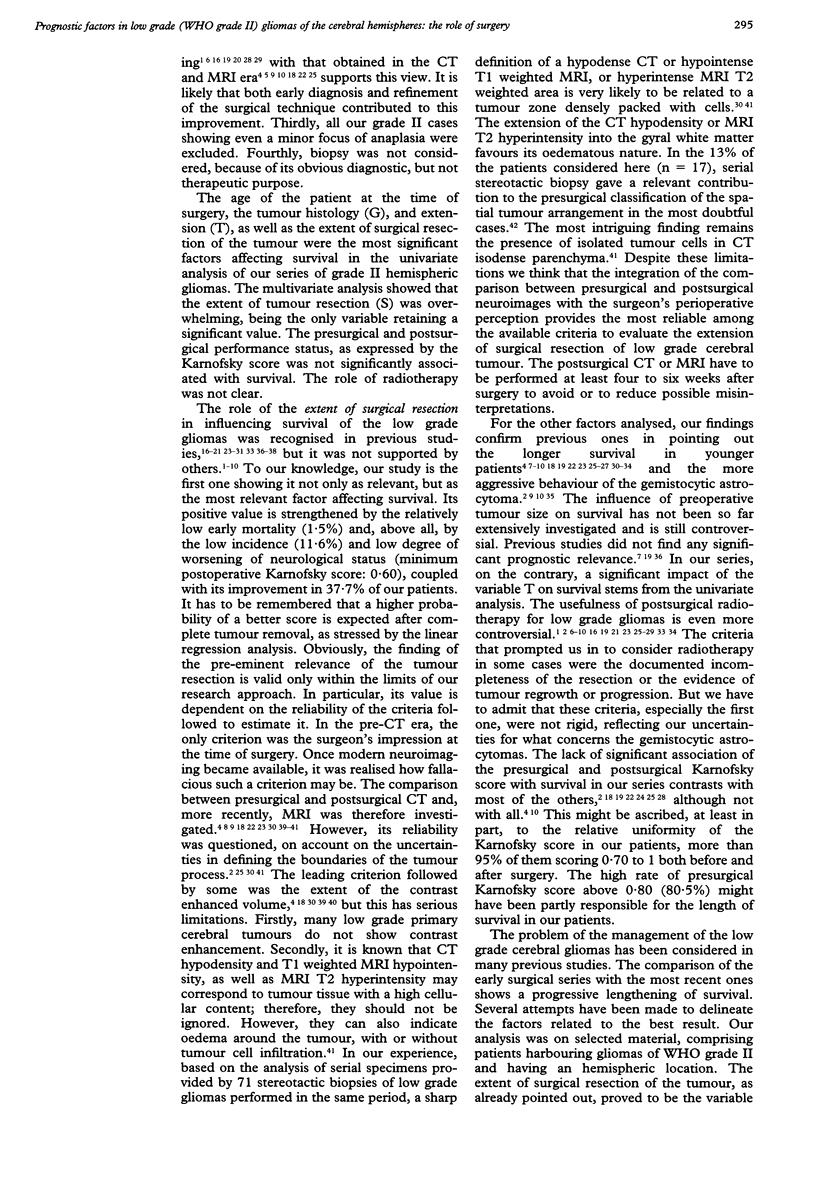
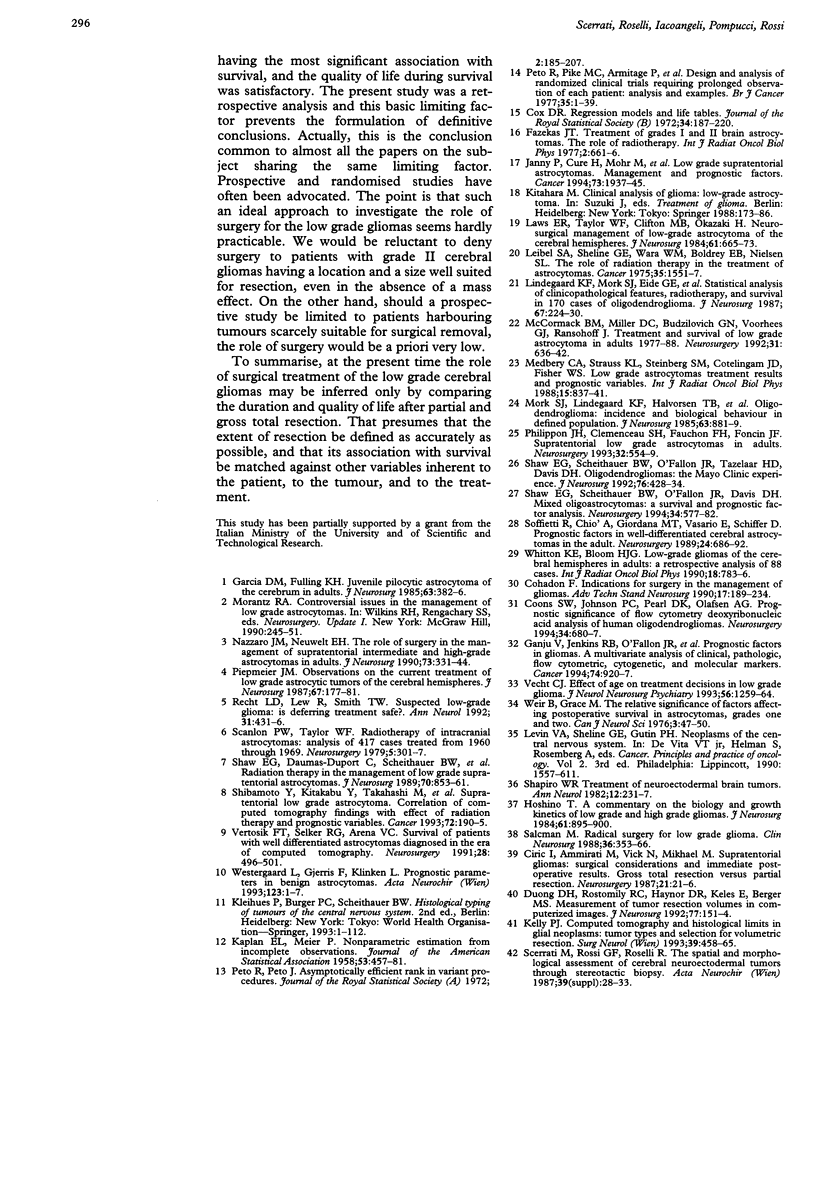
Selected References
These references are in PubMed. This may not be the complete list of references from this article.
- Ciric I., Ammirati M., Vick N., Mikhael M. Supratentorial gliomas: surgical considerations and immediate postoperative results. Gross total resection versus partial resection. Neurosurgery. 1987 Jul;21(1):21–26. doi: 10.1227/00006123-198707000-00005. [DOI] [PubMed] [Google Scholar]
- Cohadon F. Indications for surgery in the management of gliomas. Adv Tech Stand Neurosurg. 1990;17:189–234. doi: 10.1007/978-3-7091-6925-4_6. [DOI] [PubMed] [Google Scholar]
- Coons S. W., Johnson P. C., Pearl D. K., Olafsen A. G. Prognostic significance of flow cytometry deoxyribonucleic acid analysis of human oligodendrogliomas. Neurosurgery. 1994 Apr;34(4):680–687. [PubMed] [Google Scholar]
- Duong D. H., Rostomily R. C., Haynor D. R., Keles G. E., Berger M. S. Measurement of tumor resection volumes from computerized images. Technical note. J Neurosurg. 1992 Jul;77(1):151–154. doi: 10.3171/jns.1992.77.1.0151. [DOI] [PubMed] [Google Scholar]
- Fazekas J. T. Treatment of grades I and II brain astrocytomas. The role of radiotherapy. Int J Radiat Oncol Biol Phys. 1977 Jul-Aug;2(7-8):661–666. doi: 10.1016/0360-3016(77)90045-1. [DOI] [PubMed] [Google Scholar]
- Ganju V., Jenkins R. B., O'Fallon J. R., Scheithauer B. W., Ransom D. T., Katzmann J. A., Kimmel D. W. Prognostic factors in gliomas. A multivariate analysis of clinical, pathologic, flow cytometric, cytogenetic, and molecular markers. Cancer. 1994 Aug 1;74(3):920–927. doi: 10.1002/1097-0142(19940801)74:3<920::aid-cncr2820740320>3.0.co;2-4. [DOI] [PubMed] [Google Scholar]
- Garcia D. M., Fulling K. H. Juvenile pilocytic astrocytoma of the cerebrum in adults. A distinctive neoplasm with favorable prognosis. J Neurosurg. 1985 Sep;63(3):382–386. doi: 10.3171/jns.1985.63.3.0382. [DOI] [PubMed] [Google Scholar]
- Hoshino T. A commentary on the biology and growth kinetics of low-grade and high-grade gliomas. J Neurosurg. 1984 Nov;61(5):895–900. doi: 10.3171/jns.1984.61.5.0895. [DOI] [PubMed] [Google Scholar]
- Janny P., Cure H., Mohr M., Heldt N., Kwiatkowski F., Lemaire J. J., Plagne R., Rozan R. Low grade supratentorial astrocytomas. Management and prognostic factors. Cancer. 1994 Apr 1;73(7):1937–1945. doi: 10.1002/1097-0142(19940401)73:7<1937::aid-cncr2820730727>3.0.co;2-g. [DOI] [PubMed] [Google Scholar]
- Kelly P. J. Computed tomography and histologic limits in glial neoplasms: tumor types and selection for volumetric resection. Surg Neurol. 1993 Jun;39(6):458–465. doi: 10.1016/0090-3019(93)90031-u. [DOI] [PubMed] [Google Scholar]
- Laws E. R., Jr, Taylor W. F., Clifton M. B., Okazaki H. Neurosurgical management of low-grade astrocytoma of the cerebral hemispheres. J Neurosurg. 1984 Oct;61(4):665–673. doi: 10.3171/jns.1984.61.4.0665. [DOI] [PubMed] [Google Scholar]
- Leibel S. A., Sheline G. E., Wara W. M., Boldrey E. B., Nielsen S. L. The role of radiation therapy in the treatment of astrocytomas. Cancer. 1975 Jun;35(6):1551–1557. doi: 10.1002/1097-0142(197506)35:6<1551::aid-cncr2820350612>3.0.co;2-v. [DOI] [PubMed] [Google Scholar]
- Lindegaard K. F., Mørk S. J., Eide G. E., Halvorsen T. B., Hatlevoll R., Solgaard T., Dahl O., Ganz J. Statistical analysis of clinicopathological features, radiotherapy, and survival in 170 cases of oligodendroglioma. J Neurosurg. 1987 Aug;67(2):224–230. doi: 10.3171/jns.1987.67.2.0224. [DOI] [PubMed] [Google Scholar]
- McCormack B. M., Miller D. C., Budzilovich G. N., Voorhees G. J., Ransohoff J. Treatment and survival of low-grade astrocytoma in adults--1977-1988. Neurosurgery. 1992 Oct;31(4):636–642. doi: 10.1227/00006123-199210000-00004. [DOI] [PubMed] [Google Scholar]
- Medbery C. A., 3rd, Straus K. L., Steinberg S. M., Cotelingam J. D., Fisher W. S. Low-grade astrocytomas: treatment results and prognostic variables. Int J Radiat Oncol Biol Phys. 1988 Oct;15(4):837–841. doi: 10.1016/0360-3016(88)90115-0. [DOI] [PubMed] [Google Scholar]
- Mørk S. J., Lindegaard K. F., Halvorsen T. B., Lehmann E. H., Solgaard T., Hatlevoll R., Harvei S., Ganz J. Oligodendroglioma: incidence and biological behavior in a defined population. J Neurosurg. 1985 Dec;63(6):881–889. doi: 10.3171/jns.1985.63.6.0881. [DOI] [PubMed] [Google Scholar]
- Nazzaro J. M., Neuwelt E. A. The role of surgery in the management of supratentorial intermediate and high-grade astrocytomas in adults. J Neurosurg. 1990 Sep;73(3):331–344. doi: 10.3171/jns.1990.73.3.0331. [DOI] [PubMed] [Google Scholar]
- Peto R., Pike M. C., Armitage P., Breslow N. E., Cox D. R., Howard S. V., Mantel N., McPherson K., Peto J., Smith P. G. Design and analysis of randomized clinical trials requiring prolonged observation of each patient. II. analysis and examples. Br J Cancer. 1977 Jan;35(1):1–39. doi: 10.1038/bjc.1977.1. [DOI] [PMC free article] [PubMed] [Google Scholar]
- Philippon J. H., Clemenceau S. H., Fauchon F. H., Foncin J. F. Supratentorial low-grade astrocytomas in adults. Neurosurgery. 1993 Apr;32(4):554–559. doi: 10.1227/00006123-199304000-00010. [DOI] [PubMed] [Google Scholar]
- Piepmeier J. M. Observations on the current treatment of low-grade astrocytic tumors of the cerebral hemispheres. J Neurosurg. 1987 Aug;67(2):177–181. doi: 10.3171/jns.1987.67.2.0177. [DOI] [PubMed] [Google Scholar]
- Recht L. D., Lew R., Smith T. W. Suspected low-grade glioma: is deferring treatment safe? Ann Neurol. 1992 Apr;31(4):431–436. doi: 10.1002/ana.410310413. [DOI] [PubMed] [Google Scholar]
- Salcman M. Radical surgery for low-grade glioma. Clin Neurosurg. 1990;36:353–366. [PubMed] [Google Scholar]
- Scanlon P. W., Taylor W. F. Radiotherapy of intracranial astrocytomas: analysis of 417 cases treated from 1960 through 1969. Neurosurgery. 1979 Sep;5(3):301–308. [PubMed] [Google Scholar]
- Scerrati M., Rossi G. F., Roselli R. The spatial and morphological assessment of cerebral neuroectodermal tumors through stereotactic biopsy. Acta Neurochir Suppl (Wien) 1987;39:28–33. doi: 10.1007/978-3-7091-8909-2_9. [DOI] [PubMed] [Google Scholar]
- Shapiro W. R. Treatment of neuroectodermal brain tumors. Ann Neurol. 1982 Sep;12(3):231–237. doi: 10.1002/ana.410120302. [DOI] [PubMed] [Google Scholar]
- Shaw E. G., Daumas-Duport C., Scheithauer B. W., Gilbertson D. T., O'Fallon J. R., Earle J. D., Laws E. R., Jr, Okazaki H. Radiation therapy in the management of low-grade supratentorial astrocytomas. J Neurosurg. 1989 Jun;70(6):853–861. doi: 10.3171/jns.1989.70.6.0853. [DOI] [PubMed] [Google Scholar]
- Shaw E. G., Scheithauer B. W., O'Fallon J. R., Davis D. H. Mixed oligoastrocytomas: a survival and prognostic factor analysis. Neurosurgery. 1994 Apr;34(4):577–582. doi: 10.1227/00006123-199404000-00002. [DOI] [PubMed] [Google Scholar]
- Shaw E. G., Scheithauer B. W., O'Fallon J. R., Tazelaar H. D., Davis D. H. Oligodendrogliomas: the Mayo Clinic experience. J Neurosurg. 1992 Mar;76(3):428–434. doi: 10.3171/jns.1992.76.3.0428. [DOI] [PubMed] [Google Scholar]
- Shibamoto Y., Kitakabu Y., Takahashi M., Yamashita J., Oda Y., Kikuchi H., Abe M. Supratentorial low-grade astrocytoma. Correlation of computed tomography findings with effect of radiation therapy and prognostic variables. Cancer. 1993 Jul 1;72(1):190–195. doi: 10.1002/1097-0142(19930701)72:1<190::aid-cncr2820720134>3.0.co;2-y. [DOI] [PubMed] [Google Scholar]
- Soffietti R., Chiò A., Giordana M. T., Vasario E., Schiffer D. Prognostic factors in well-differentiated cerebral astrocytomas in the adult. Neurosurgery. 1989 May;24(5):686–692. doi: 10.1227/00006123-198905000-00005. [DOI] [PubMed] [Google Scholar]
- Vecht C. J. Effect of age on treatment decisions in low-grade glioma. J Neurol Neurosurg Psychiatry. 1993 Dec;56(12):1259–1264. doi: 10.1136/jnnp.56.12.1259. [DOI] [PMC free article] [PubMed] [Google Scholar]
- Vertosick F. T., Jr, Selker R. G., Arena V. C. Survival of patients with well-differentiated astrocytomas diagnosed in the era of computed tomography. Neurosurgery. 1991 Apr;28(4):496–501. doi: 10.1097/00006123-199104000-00002. [DOI] [PubMed] [Google Scholar]
- Weir B., Grace M. The relative significance of factors affecting postoperative survival in astrocytomas, grades one and two. Can J Neurol Sci. 1976 Feb;3(1):47–50. doi: 10.1017/s0317167100025993. [DOI] [PubMed] [Google Scholar]
- Westergaard L., Gjerris F., Klinken L. Prognostic parameters in benign astrocytomas. Acta Neurochir (Wien) 1993;123(1-2):1–7. doi: 10.1007/BF01476278. [DOI] [PubMed] [Google Scholar]
- Whitton A. C., Bloom H. J. Low grade glioma of the cerebral hemispheres in adults: a retrospective analysis of 88 cases. Int J Radiat Oncol Biol Phys. 1990 Apr;18(4):783–786. doi: 10.1016/0360-3016(90)90397-3. [DOI] [PubMed] [Google Scholar]


